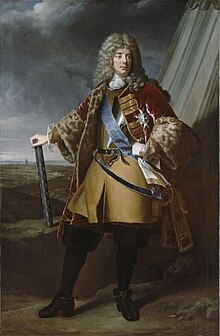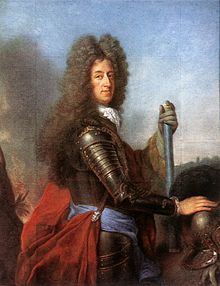Bombardment of Brussels
Led by King Louis XIV and the Duke of Villeroi, French forces bombarded the city in an attempt to divert Grand Alliance troops from reinforcing the concurrent siege of Namur.The French attempt to divert the Grand Alliance was ultimately unsuccessful, though Louis XIV's reputation suffered for his involvement in the destruction of the city.Opposing France was a large European coalition, the Grand Alliance, with its head as William III of Orange, leader of the Netherlands, and soon to be king of England.He evaluated that 12 cannons, 25 mortars, 4000 cannonballs, 5000 explosive shells, a large amount of gunpowder, lead shot, grenades and fuses, and 900 wagons for transport would be necessary.The supplies and troops were largely taken out of French garrisons and strongholds in the region, and on August 7, Villeroi left Mons for Brussels with a baggage train of nearly 1500 carts.The city's authorities believed until the last minute that the worst could be avoided, and as such urged the populace to stay home with buckets of water, so as to be prepared to extinguish any fire and prevent its spread.So feeble a means of stopping the fire quickly proved useless, and the panicked residents tried to save their most precious belongings and fled to the heights of the city, east of the Senne valley.By the middle of the night, the entire heart of the city was aflame, including the stone buildings of the Grand-Place and its surroundings, the Town Hall, abandoned by the authorities and whose spire was being used as a target by the French artillery, the Breadhouse, the Recollet convent and St. Nicholas' Church, whose bell fell on and crushed the neighbouring houses.The area around what is now the Brussels-Central railway station and the Chapel of Mary Magdalene of Brussels were ablaze, and the Recollet convent, already hit the night before, was near completely destroyed.[4] Constantijn Huygens, William's Secretary for Dutch affairs, visited Brussels and in his diary entry for September 11, he writes that the 'ruin caused...was horrible...and in many places, the houses reduced to rubble."[12] The young Duke of Berwick, a future Marshal of France who was present, disapproved, writing at the end of his life "A more appalling spectacle has never been seen, and nothing else comes as close to the sack of Troy."[13] The action was widely condemned throughout Europe, as it contravened an accepted convention of siege warfare, i.e. bombardments were used to smash a city's defenses, or destroy military infrastructure, rather than simply targeting the civilian population.[16] From the days following the bombardment into the following months, the different authorities of the city implemented a series of measures and regulations in order to attend to the most urgent problems and begin the reconstruction.By opening Brussels to the outside commercially, the guilds' monopoly was renounced and opportunities for profiting from the disaster were reduced, in order to bring the city back to normal as quickly as possible.Turin in particular was characterized by its logical street layout, with straight avenues offering long, uninterrupted views flanked by buildings of a uniform size.[17] He also insisted on this point when dealing with the Magistracy, saying "..we strongly hope that some order and uniformity has been observed in the buildings, and ... for the beauty and convenience of the city, that the streets which were formerly too narrow have now been enlarged.The weakness of the central government and the governor's absence due to the war during the first stages of reconstruction, in addition to the strength of the local upper classes, resulted in the structure of the city being kept largely the same, a situation similar to that after the Great Fire of London in 1666.Despite the necessity of rapid reconstruction and the lack of financial means, authorities took several measures to improve traffic flow, sanitation and the general aesthetics of the city.The reconstruction was of an exceptional speed, and took place in an atmosphere of hope for sustained peace following the fall of the Citadel of Namur and the Treaty of Ryswick, both of which were extensively celebrated in the city.



Middle: The Breadhouse burning
Bottom: Diagram of a mortar



Nine Years' WarBrusselsSouthern NetherlandsFranceLouis XIVDuke of VilleroiPhilippe de BerghesWalcourtFleurus1st NamurSteenkerqueLanden2nd Huy2nd Namur2nd DiksmuidePhilippsburgStaffardaMarsagliaBarretinasSecond BrotherhoodTorroellaSant Esteve d'en BasBarcelonaIrelandBandonDromoreNewtownbutlerCarrickfergus1st AthloneWaterford1st LimerickCork and Kinsale2nd AthloneAughrim2nd LimerickEnglandScotlandInvasion of EnglandWincantonReadingLoup HillKilliecrankieDunkeldCromdaleGlencoe1st GuáricoCartagena de IndiasBantry BayBeachy HeadBarfleur and La HogueBarfleurCherbourgLa HogueCamaretDogger BankHudson Bay (1686)1st Fort Albany2nd Fort AlbanyYork FactoryHudson Bay (1697)LachineSchenectadyQuebecLa PrairieMohawk ValleyWilton1st PemaquidSalmon FallsPort RoyalFalmouthChedabucto1st St. JohnPlacentiaOyster RiverGroton2nd St. John2nd PemaquidChignectoFort NashwaakNewfoundlandHaverhillFrench Royal ArmyGrand Alliancesiege of Namurhistory of BrusselsGrand-Place/Grote MarktWar of the Spanish SuccessionBattle of the DunesWilliam III of OrangeSwedenHoly Roman EmpireMaximilian II Emanuel, Elector of BavariaSpanish Netherlandswas besiegedDuke of LuxembourgBrugesFrançois de Neufville, Duke of Villeroymortarscannonballsexplosive shellsgunpowdergrenadesMaximilian II EmanuelPrince of Vaudemontits wallsFlanders GateAnderlecht GatePhilippe François de BerghesEnglish ChannelTheresa KunegundaJohn III SobieskiTown HallBreadhousebatterieswestern ramparts of the citycobblestonesducal palaceGrand-PlaceRecolletSt. Nicholas' Churchthe MintSt. Michael and Gudula CathedralBrussels-Central railway stationChurch of the Chapelbrazierfirebreak